-
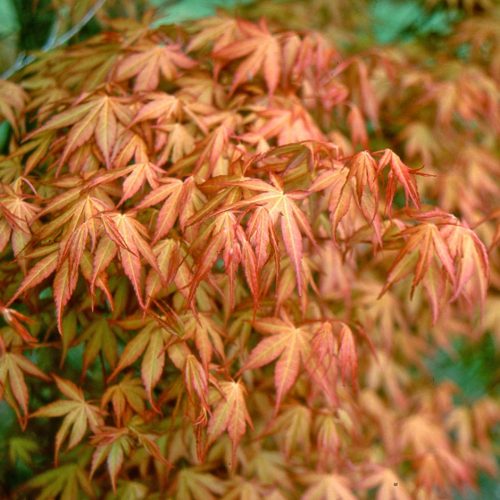 Acer Katsura is a stunning maple with beautiful orange - yellow leaves tinged with a reddish hue that change colour throughout the season. This deciduous variety looks stunning all spring, summer and especially in autumn. Pot size: 3L Position: full sun (but not south-facing) Soil: fertile, moist, well-drained neutral to acid soil Rate of growth: slow-growing Flowering period: April to May Hardiness: fully hardy Garden care: Add a top-dressing of a well-balanced fertiliser around the base of a recently planted tree in late spring and keep it well watered. No routine pruning is required, just remove any dead, damaged or crossing branches in late autumn or winter when they are fully dormant. Eventual Height: 4m Eventual Spread: 4m
Acer Katsura is a stunning maple with beautiful orange - yellow leaves tinged with a reddish hue that change colour throughout the season. This deciduous variety looks stunning all spring, summer and especially in autumn. Pot size: 3L Position: full sun (but not south-facing) Soil: fertile, moist, well-drained neutral to acid soil Rate of growth: slow-growing Flowering period: April to May Hardiness: fully hardy Garden care: Add a top-dressing of a well-balanced fertiliser around the base of a recently planted tree in late spring and keep it well watered. No routine pruning is required, just remove any dead, damaged or crossing branches in late autumn or winter when they are fully dormant. Eventual Height: 4m Eventual Spread: 4m -
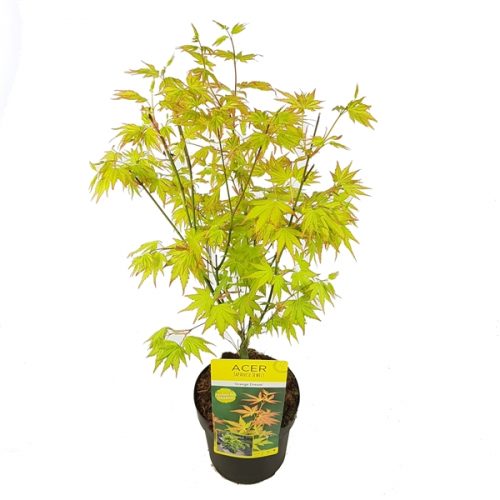
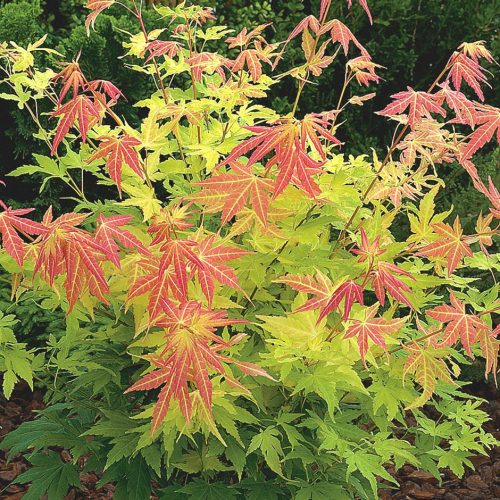 Orange Dream' is a medium sized bushy deciduous shrub, to 3m, with leaf colour varying at different seasons, yellow in spring, greenish in summer, orange-yellow in autumn. Bark is bright green. Redddish-purple flowers may be followed by red fruits Pot size: 3L Plant Size • Mature Height: 2.5-4 metres • Mature Spread: 2.5-4 metres Why We Love It • Perfect as a spciment plant in cottage gardens, city gardens or for rock gardens an containers • Low maintenace What To Know • Season of Interest: Spring-Autumn • Position: Full sun, partial shade • Soil: Moist but well drained, organically rich How to Care • Pruning should be carried out in the dormant season (November to March) as Japanese Maples bleed during other times of the year, which can weaken the branches. • Water in summer if necessary. • Leaf colour is best in partial shade, although full sun can be tolerated. • Add a top-dressing of a well-balanced fertiliser around the base of a recently planted tree in late spring and keep it well watered. No routine pruning is required, just remove any dead, damaged or crossing branches in late autumn or winter when they are fully dormant.
Orange Dream' is a medium sized bushy deciduous shrub, to 3m, with leaf colour varying at different seasons, yellow in spring, greenish in summer, orange-yellow in autumn. Bark is bright green. Redddish-purple flowers may be followed by red fruits Pot size: 3L Plant Size • Mature Height: 2.5-4 metres • Mature Spread: 2.5-4 metres Why We Love It • Perfect as a spciment plant in cottage gardens, city gardens or for rock gardens an containers • Low maintenace What To Know • Season of Interest: Spring-Autumn • Position: Full sun, partial shade • Soil: Moist but well drained, organically rich How to Care • Pruning should be carried out in the dormant season (November to March) as Japanese Maples bleed during other times of the year, which can weaken the branches. • Water in summer if necessary. • Leaf colour is best in partial shade, although full sun can be tolerated. • Add a top-dressing of a well-balanced fertiliser around the base of a recently planted tree in late spring and keep it well watered. No routine pruning is required, just remove any dead, damaged or crossing branches in late autumn or winter when they are fully dormant. -
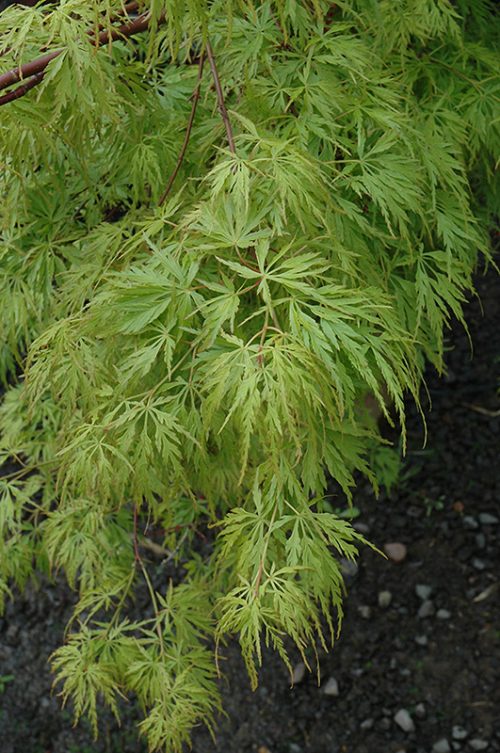 This lovely, green, dissected leafed Japanese Maple tree makes for a colourful splash in the garden. The lacy foliage is a bright, lime green throughout the spring and mid green in the summer, sometimes with a red tinge, before turning gold and red in the autumn. Acer palmatum dissectum 'Seiryu' is an unusual variety, as it is the only green dissected Japanese Maple tree with an upright growth habit, rather than the usual domed or weeping forms. Acer Seiryu has a striking vase shape which broadens slightly to a rounder form with age, eventually reaching a height and spread of 4 x 4 metres in 20 years. This dissected Acer tree is best positioned in a moist, well-drained soil in slight shade although it is tolerant of full sun. Acer palmatum 'Seiryu' makes a fantastic large shrub or small garden tree that offers an attractive, light canopy throughout the spring, summer and autumn. Pot size: 3L
This lovely, green, dissected leafed Japanese Maple tree makes for a colourful splash in the garden. The lacy foliage is a bright, lime green throughout the spring and mid green in the summer, sometimes with a red tinge, before turning gold and red in the autumn. Acer palmatum dissectum 'Seiryu' is an unusual variety, as it is the only green dissected Japanese Maple tree with an upright growth habit, rather than the usual domed or weeping forms. Acer Seiryu has a striking vase shape which broadens slightly to a rounder form with age, eventually reaching a height and spread of 4 x 4 metres in 20 years. This dissected Acer tree is best positioned in a moist, well-drained soil in slight shade although it is tolerant of full sun. Acer palmatum 'Seiryu' makes a fantastic large shrub or small garden tree that offers an attractive, light canopy throughout the spring, summer and autumn. Pot size: 3L -
Out of stock
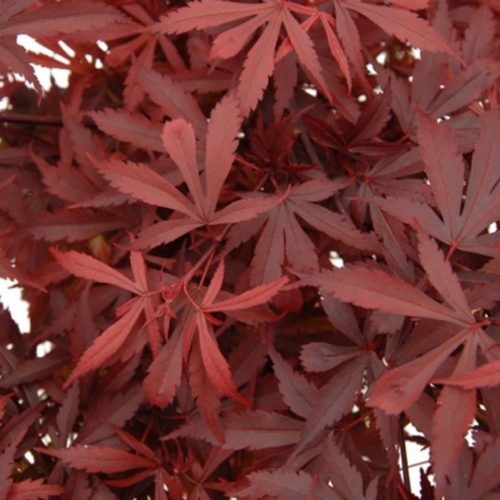 A small deciduous tree that has been in cultivation in Japan for a very long time. The fresh, delicate looking foliage is almost transparent in the sunlight and the overall shape of Japanese Maples make them an excellent choice as a specimen tree in a sheltered spot. Acer Palmatum Atropurpureum is the dark purple-leaved form of the common Japanese maple with exceptionally great Autumn colour. Growing notes: Acer palmatum and its cultivars are slow growing and do not really require pruning, but will tolerate it if necessary - remove damaged, diseased or crossing branches - it is best done during the dormant months. Lower branches can be taken off to shape the canopy over time. Japanese maples all require shelter from wind to avoid wind scorch. The very fine leaved cultivars need extra protection from wind and the sun. Despite being hardy, the fresh growth can be vulnerable to frost in the Spring. They all tolerate growing in a large container, some for a very long time.
A small deciduous tree that has been in cultivation in Japan for a very long time. The fresh, delicate looking foliage is almost transparent in the sunlight and the overall shape of Japanese Maples make them an excellent choice as a specimen tree in a sheltered spot. Acer Palmatum Atropurpureum is the dark purple-leaved form of the common Japanese maple with exceptionally great Autumn colour. Growing notes: Acer palmatum and its cultivars are slow growing and do not really require pruning, but will tolerate it if necessary - remove damaged, diseased or crossing branches - it is best done during the dormant months. Lower branches can be taken off to shape the canopy over time. Japanese maples all require shelter from wind to avoid wind scorch. The very fine leaved cultivars need extra protection from wind and the sun. Despite being hardy, the fresh growth can be vulnerable to frost in the Spring. They all tolerate growing in a large container, some for a very long time.- Cultivars with green or yellow foliage are best grown in dappled shade as full sun can scorch the leaves.
- Cultivars with purple or red foliage require some sun to fully develop their dark colour.
- Cultivars with variegated foliage require shade from the afternoon sun to prevent scorching.
-
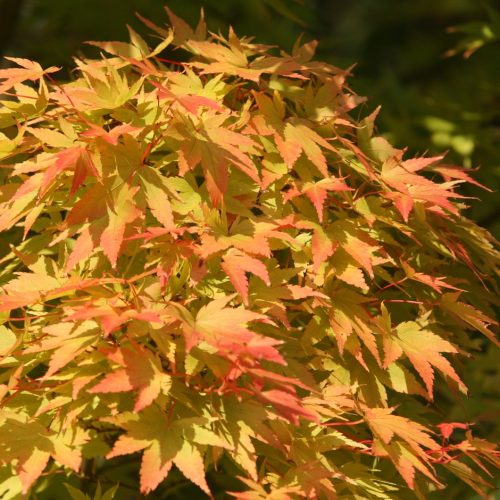 Acer 'Sangokaku' is a compact, bushy acer growing to.5m tall in 10 years. The leaves emerge green in spring, turning a ellow, orange before falling. Pot Size: 3L Plant Size • Mature Height: 5m • Mature Spread: 2m Why We Love It • Perfect as a spciment plant in cottage gardens, city gardens or for rock gardens an containers • Low maintenace What To Know • Season of Interest: Spring-Autumn • Position: Full sun, partial shade • Soil: Moist but well drained, organically rich How to Care • Pruning should be carried out in the dormant season (November to March) as Japanese Maples bleed during other times of the year, which can weaken the branches. • Water in summer if necessary. • Leaf colour is best in partial shade, although full sun can be tolerated. • Add a top-dressing of a well-balanced fertiliser around the base of a recently planted tree in late spring and keep it well watered. No routine pruning is required, just remove any dead, damaged or crossing branches in late autumn or winter when they are fully dormant.
Acer 'Sangokaku' is a compact, bushy acer growing to.5m tall in 10 years. The leaves emerge green in spring, turning a ellow, orange before falling. Pot Size: 3L Plant Size • Mature Height: 5m • Mature Spread: 2m Why We Love It • Perfect as a spciment plant in cottage gardens, city gardens or for rock gardens an containers • Low maintenace What To Know • Season of Interest: Spring-Autumn • Position: Full sun, partial shade • Soil: Moist but well drained, organically rich How to Care • Pruning should be carried out in the dormant season (November to March) as Japanese Maples bleed during other times of the year, which can weaken the branches. • Water in summer if necessary. • Leaf colour is best in partial shade, although full sun can be tolerated. • Add a top-dressing of a well-balanced fertiliser around the base of a recently planted tree in late spring and keep it well watered. No routine pruning is required, just remove any dead, damaged or crossing branches in late autumn or winter when they are fully dormant. -
 Acer 'Sangokaku' is a compact, bushy acer growing to 5m tall in 10 years. The leaves emerge green in spring, turning a yellow, orange before falling. Pot Size: 5L Plant Size • Mature Height: 5m • Mature Spread: 2m Why We Love It • Perfect as a spciment plant in cottage gardens, city gardens or for rock gardens an containers • Low maintenace What To Know • Season of Interest: Spring-Autumn • Position: Full sun, partial shade • Soil: Moist but well drained, organically rich How to Care • Pruning should be carried out in the dormant season (November to March) as Japanese Maples bleed during other times of the year, which can weaken the branches. • Water in summer if necessary. • Leaf colour is best in partial shade, although full sun can be tolerated. • Add a top-dressing of a well-balanced fertiliser around the base of a recently planted tree in late spring and keep it well watered. No routine pruning is required, just remove any dead, damaged or crossing branches in late autumn or winter when they are fully dormant.
Acer 'Sangokaku' is a compact, bushy acer growing to 5m tall in 10 years. The leaves emerge green in spring, turning a yellow, orange before falling. Pot Size: 5L Plant Size • Mature Height: 5m • Mature Spread: 2m Why We Love It • Perfect as a spciment plant in cottage gardens, city gardens or for rock gardens an containers • Low maintenace What To Know • Season of Interest: Spring-Autumn • Position: Full sun, partial shade • Soil: Moist but well drained, organically rich How to Care • Pruning should be carried out in the dormant season (November to March) as Japanese Maples bleed during other times of the year, which can weaken the branches. • Water in summer if necessary. • Leaf colour is best in partial shade, although full sun can be tolerated. • Add a top-dressing of a well-balanced fertiliser around the base of a recently planted tree in late spring and keep it well watered. No routine pruning is required, just remove any dead, damaged or crossing branches in late autumn or winter when they are fully dormant. -
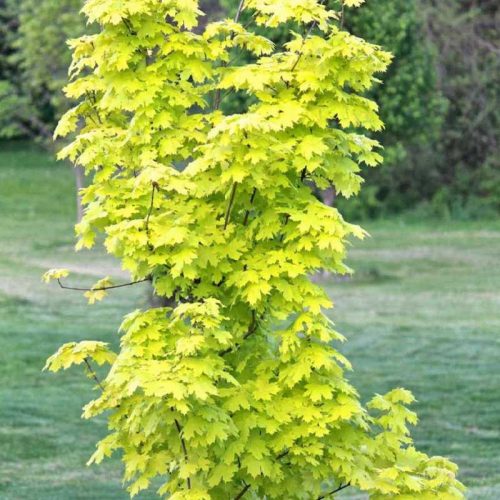 Grow for its bright golden foliage and stately form, Acer platanoides Princeton Gold is a tall, fast-growing, long-lived, deciduous tree with a bushy, broadly columnar habit. Typical five-lobed maple leaves emerge pale gold on red leaf-stalks, turning a rich golden-yellow as the season progresses. Inconspicuous yellowish flowers are followed by winged ‘helicopter’ seeds in autumn. Tough and easy to grow and maintain, Norway Maple Princeton Gold makes a beautiful specimen tree, colouring best in full sun. Site: Tolerates exposure Soil: Any well drained soil, preferably moist Position: Full sun or partial shade Season of interest: Spring to autumn Hardiness: Very hardy Height: Eventually over 40’ (12m) Spread: 26’ (8m)
Grow for its bright golden foliage and stately form, Acer platanoides Princeton Gold is a tall, fast-growing, long-lived, deciduous tree with a bushy, broadly columnar habit. Typical five-lobed maple leaves emerge pale gold on red leaf-stalks, turning a rich golden-yellow as the season progresses. Inconspicuous yellowish flowers are followed by winged ‘helicopter’ seeds in autumn. Tough and easy to grow and maintain, Norway Maple Princeton Gold makes a beautiful specimen tree, colouring best in full sun. Site: Tolerates exposure Soil: Any well drained soil, preferably moist Position: Full sun or partial shade Season of interest: Spring to autumn Hardiness: Very hardy Height: Eventually over 40’ (12m) Spread: 26’ (8m) -
Out of stock
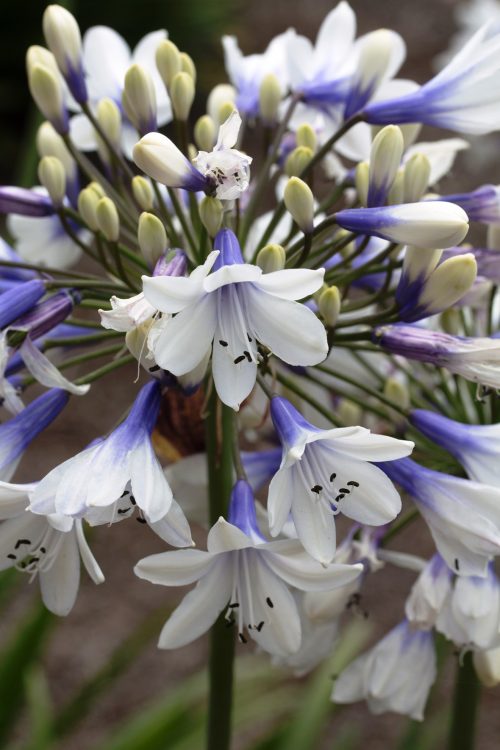
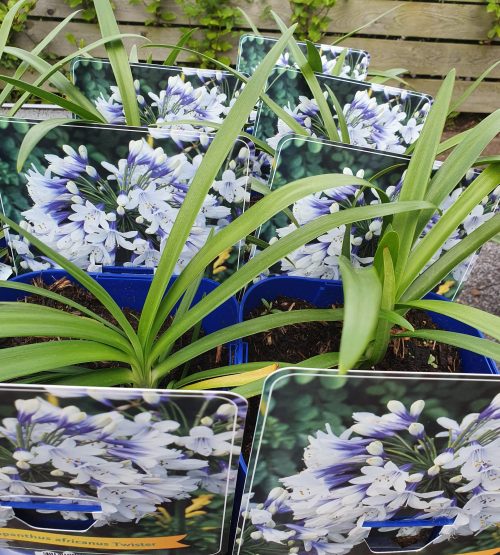 A compact, bi-coloured form of Agapanthus or African lily, Agapanthus Twister is a clump-forming, deciduous perennial, ideal for the smaller garden. Strap-like, deep green leaves appear in spring. From July to September, large, globular flower-heads of trumpet-shaped, white florets with a violet-blue base are borne on sturdy stems. African lilies are very good in pots, grown in soil-based compost with slow-release fertiliser granules, as they flower well when their roots are confined, but be aware that pot-grown plants are more vulnerable to frost, so the pots should be brought under cover in winter in colder areas. African lily Twister holds the RHS Award of Garden Merit. Site: Sheltered Soil: Any light, moisture-retentive, well-drained soil Position: Full sun Season of interest: July to September Hardiness: Fairly hardy Height: 70cm Spread: 40cm
A compact, bi-coloured form of Agapanthus or African lily, Agapanthus Twister is a clump-forming, deciduous perennial, ideal for the smaller garden. Strap-like, deep green leaves appear in spring. From July to September, large, globular flower-heads of trumpet-shaped, white florets with a violet-blue base are borne on sturdy stems. African lilies are very good in pots, grown in soil-based compost with slow-release fertiliser granules, as they flower well when their roots are confined, but be aware that pot-grown plants are more vulnerable to frost, so the pots should be brought under cover in winter in colder areas. African lily Twister holds the RHS Award of Garden Merit. Site: Sheltered Soil: Any light, moisture-retentive, well-drained soil Position: Full sun Season of interest: July to September Hardiness: Fairly hardy Height: 70cm Spread: 40cm -
Out of stock
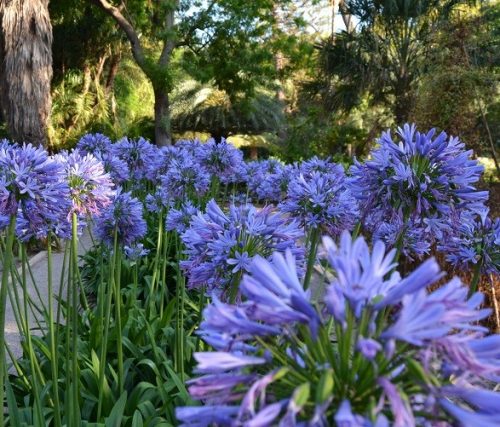
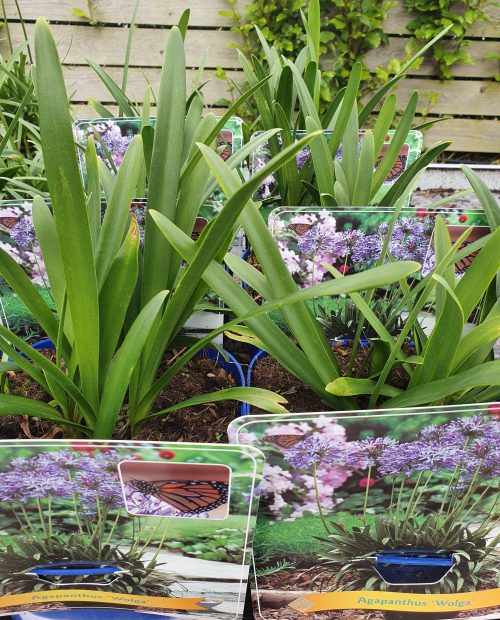 Agapanthus Wolga, Deciduous green strap-like leaves. Pale violet-blue flowers, flowerhead 18-20cm in diameter. Grows up to 70cm tall. Requires full sun and moist well drained soil conditions. Give winter protection. Site: Sheltered Soil: Any light, moisture-retentive, well-drained soil Position: Full sun Season of interest: July to September Hardiness: Fairly hardy Height: 70cm Spread: 40cm
Agapanthus Wolga, Deciduous green strap-like leaves. Pale violet-blue flowers, flowerhead 18-20cm in diameter. Grows up to 70cm tall. Requires full sun and moist well drained soil conditions. Give winter protection. Site: Sheltered Soil: Any light, moisture-retentive, well-drained soil Position: Full sun Season of interest: July to September Hardiness: Fairly hardy Height: 70cm Spread: 40cm -
Out of stock
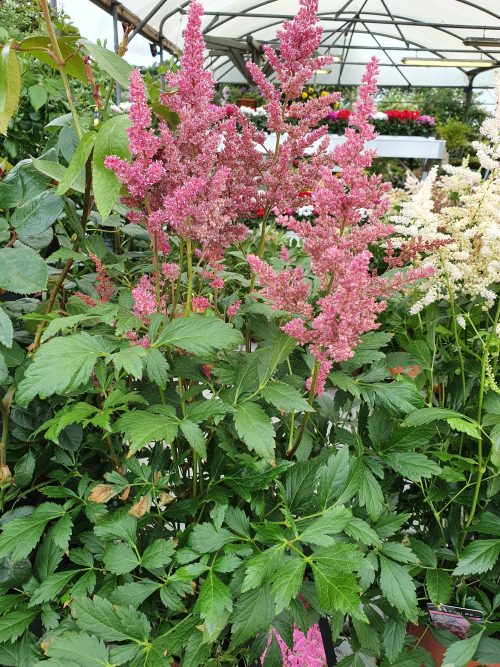
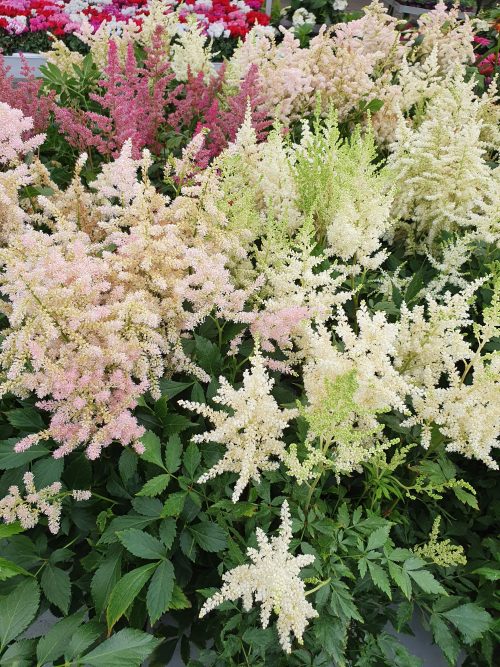
-
Out of stock
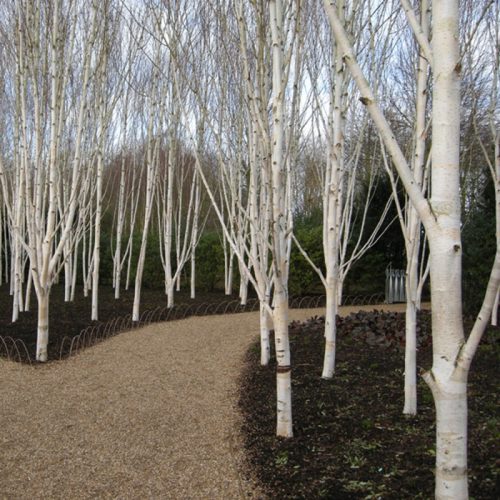 Betula Jacquemontii is a vigorous deciduous tree with brilliant white bark on the trunk and larger branches; ovate leaves turn yellow in autumn; yellow-brown male catkins open in early spring. CHARACTERISTICS:
Betula Jacquemontii is a vigorous deciduous tree with brilliant white bark on the trunk and larger branches; ovate leaves turn yellow in autumn; yellow-brown male catkins open in early spring. CHARACTERISTICS:- Soil: Moist, well-drained soil
- Max. Height & Spread: H-18 m or higher x S-10 m
- Season of Interest: Spring
- Position: Full Sun or Partial Shade
- Hardiness: Hardy
-
Out of stock
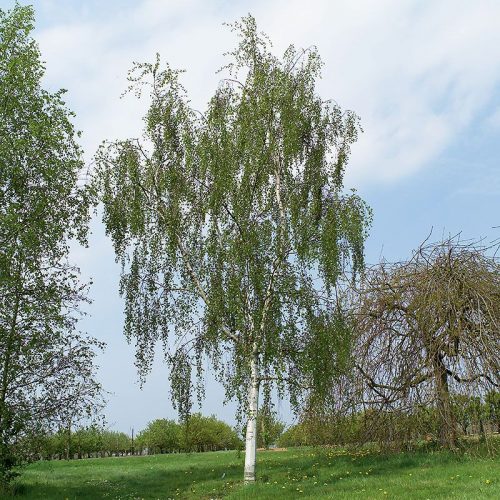 Betula Pendula Tristis is a tall and graceful tree with pendulous branches that are heavily weeping and twisted at the tips supporting a cloth of blue/green leaves. Catkins appear in the spring and the slightly serrated foliage turns creamy yellow in the autumn. This elegantly shaped birch tree casts a dappled shade and looks particularly attractive in the winter when its majestic form is fully revealed by bare branches. The beautiful, silvery smooth white bark provides year round interest and is a canvas to contrasting dark cracks and fissures that develop with age. Tristis is suited to most soil types and a 20 year height and spread of 7 x 4 metres can be expected. Pot size: 10L Height at the moment: 180cm-200cm
Betula Pendula Tristis is a tall and graceful tree with pendulous branches that are heavily weeping and twisted at the tips supporting a cloth of blue/green leaves. Catkins appear in the spring and the slightly serrated foliage turns creamy yellow in the autumn. This elegantly shaped birch tree casts a dappled shade and looks particularly attractive in the winter when its majestic form is fully revealed by bare branches. The beautiful, silvery smooth white bark provides year round interest and is a canvas to contrasting dark cracks and fissures that develop with age. Tristis is suited to most soil types and a 20 year height and spread of 7 x 4 metres can be expected. Pot size: 10L Height at the moment: 180cm-200cm -
Out of stock
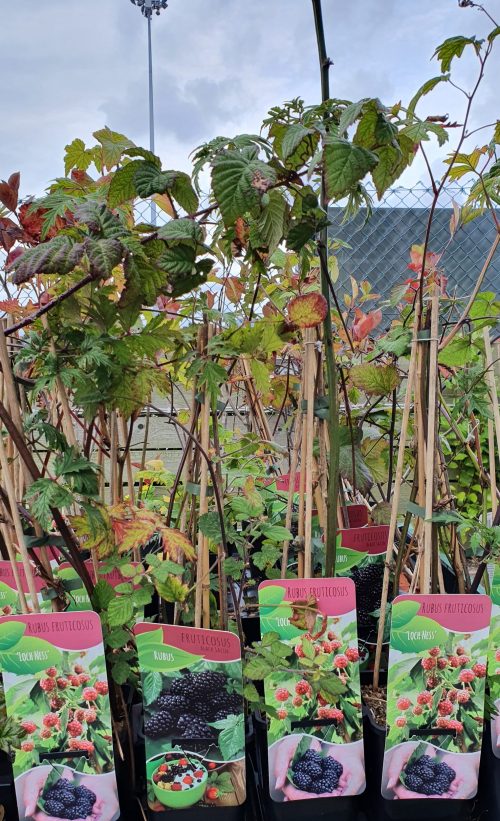
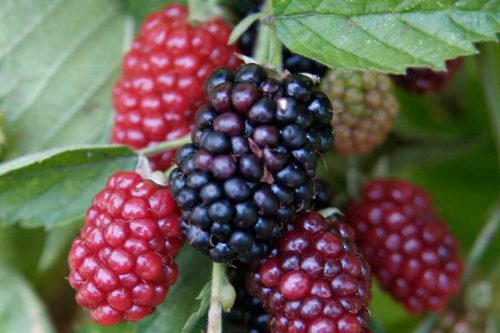 2.5m ht x 2.5m sp 2-5 years until maturity ‘Loch Ness’ is a moderate-sized bush with upright thornless canes, white flowers in summer followed by dark blackberries in late summer.
2.5m ht x 2.5m sp 2-5 years until maturity ‘Loch Ness’ is a moderate-sized bush with upright thornless canes, white flowers in summer followed by dark blackberries in late summer.Foliage
DeciduousHabit
SpreadingFlower
White in SummerFoliage
Dark-green in Spring; Dark-green in Summer; Pale-yellow in AutumnHOW TO CARE
Watch out for
Pests
It is best to rotate crops to avoid pest and disease problems.Specific pests
Aphids , Leafhoppers , Raspberry beetle , Raspberry leaf and bud miteGeneral care
Pruning
Prune old canes to ground level in late winter and tie in new canes.Propagation methods
LayeringWHERE TO GROW
Rubus fruticosus 'Loch Ness' (Blackberry 'Loch Ness') will reach a height of 2.5m and a spread of 2.5m after 2-5 years.Suggested uses
Add to salads, Banks and Slopes, Cake decoration, Containers, Cottage/Informal, Flavouring food and drinks, Hedging/ScreensCultivation
Plant outdoors in summer in well-drained neutral soil.Soil type
Clay, Loamy, SandySoil drainage
Moist but well-drained, Well-drainedSoil pH
NeutralLight
Full SunAspect
South, East, WestExposure
Sheltered -
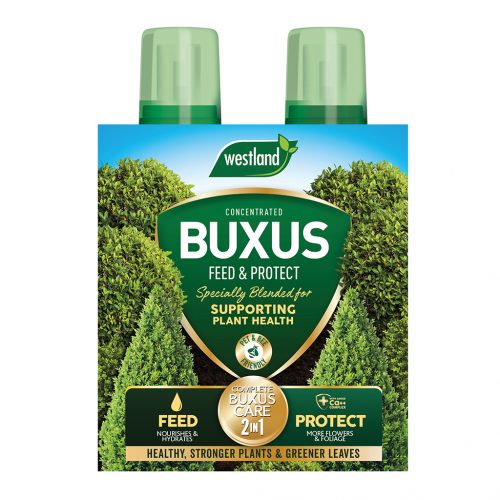
- Buxus Feed & Protect has been specially formulated to strengthen the plant from within. This 2-in-1 solution comprises of two bottles; the first contains a concentrated Buxus feed for greener, healthier foliage; the second contains a protection concentrate to deter box blight. For use on all types of Buxus plants
- Can be used from early spring through to late summer
- Helps Buxus retain water for a healthier plant
- Sulphur and calcium strengthen from within
- Soil improver to give plants the best start
- Child, pet and bee-friendly
- 2 x 500ml bottles
-
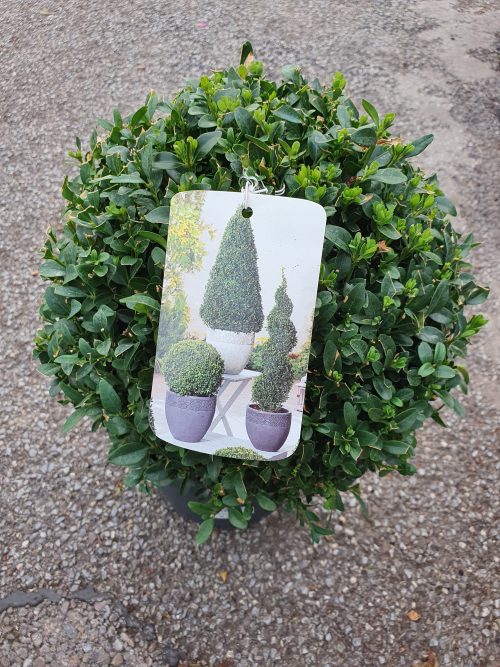
- Position: partial shade
- Soil: fertile, well-drained soil
- Rate of growth: slow-growing
- Hardiness: fully hardyA pair of these tightly clipped box spheres look great flanking a set of steps, a doorway or a path. One of our recommended plants, they're perfect for planting in a large terracotta pot in a partially shady site, where the glossy, dark-green leaves provide all year foliage, interest and structure. Box are happy growing in a sunnier spot, but the combination of dry soil and full sun may encourage poor growth and leaf scorching. If you have sandy soil it is best to keep them in a partially shady spot in the garden.
- Garden care: Ensure that the soil or compost is never allowed to dry out. Trim plants grown as hedges or topiary in mid- or late summer. If you want to maintain a really precise outline, then you can clip it twice a year - once in June, and then again in August/September. Apply a top-dressing of a balanced slow-release fertiliser such as blood, fish and bone (organic) or Growmore (inorganic) around the base of the plant in spring, making sure that none touches the leaves or stems.
-
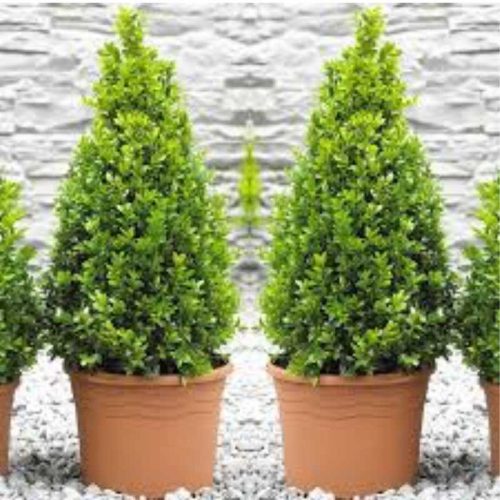
- Position: partial shade
- Soil: fertile, well-drained soil
- Rate of growth: slow-growing
- Hardiness: fully hardy A pair of these tightly clipped box spheres look great flanking a set of steps, a doorway or a path. One of our recommended plants, they're perfect for planting in a large terracotta pot in a partially shady site, where the glossy, dark-green leaves provide all year foliage, interest and structure. Box are happy growing in a sunnier spot, but the combination of dry soil and full sun may encourage poor growth and leaf scorching. If you have sandy soil it is best to keep them in a partially shady spot in the garden.
- Garden care: Ensure that the soil or compost is never allowed to dry out. Trim plants grown as hedges or topiary in mid- or late summer. If you want to maintain a really precise outline, then you can clip it twice a year - once in June, and then again in August/September. Apply a top-dressing of a balanced slow-release fertiliser such as blood, fish and bone (organic) or Growmore (inorganic) around the base of the plant in spring, making sure that none touches the leaves or stems.
-
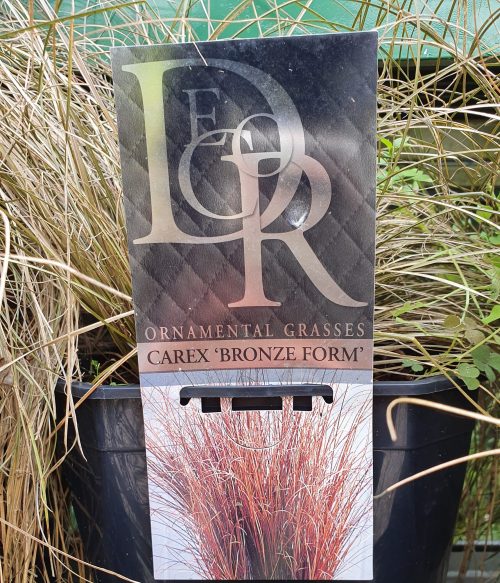
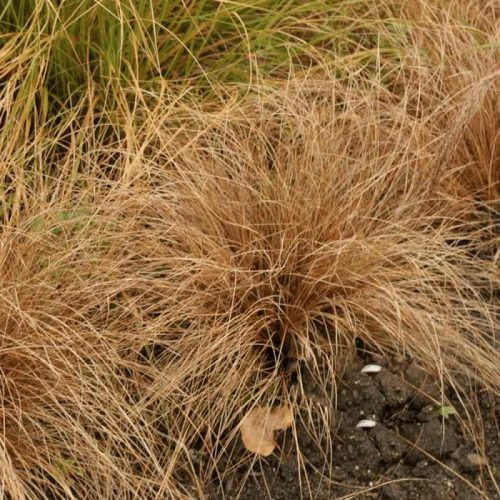 Water & Maintenance: Average watering required, low maintenance shrubs Growth & Spread: Height 0.5m - 1m, Spread 0.5m - 1m Flourishing Season: Flourishes all-round the year, flowers in June - July Characteristics: Evergreen shrubs, forms perfect architectural mound, narrow bronze leaves, tiny brown flowers, suitable for edging in rock garden
Water & Maintenance: Average watering required, low maintenance shrubs Growth & Spread: Height 0.5m - 1m, Spread 0.5m - 1m Flourishing Season: Flourishes all-round the year, flowers in June - July Characteristics: Evergreen shrubs, forms perfect architectural mound, narrow bronze leaves, tiny brown flowers, suitable for edging in rock garden -
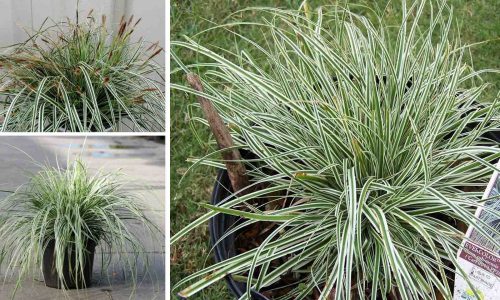
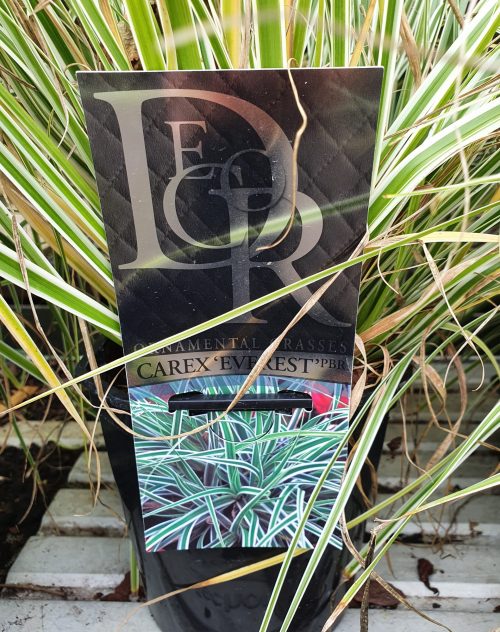 ‘Everest’ is a dense, tufted, evergreen, perennial grass forming a mound of narrow, arching, glossy, dark green leaves with white margins and lax stems bearing brown flower spikes in summer. 0.6m height x 0.6m spread 2-5 years until maturity
‘Everest’ is a dense, tufted, evergreen, perennial grass forming a mound of narrow, arching, glossy, dark green leaves with white margins and lax stems bearing brown flower spikes in summer. 0.6m height x 0.6m spread 2-5 years until maturity -
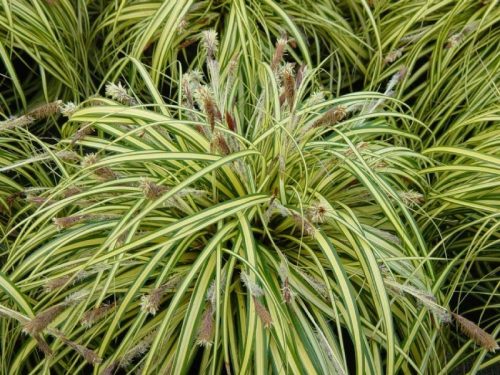
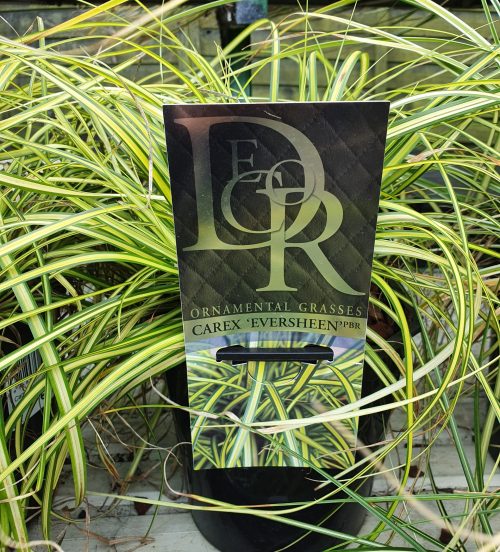 The citrus lemon-yellow blades edged in green add a refreshing zest even in the winter garden. Neat habit is perfect for container planting. Colorful year-round, the flowing arching mounds of Carex Eversheen is perfectly suited for shade, but can handle some sun in cooler climates. A pleasing addition to any spot as it bends and sways with the warm summer breezes. A nice edger. 0.4m height x 0.4m spread
The citrus lemon-yellow blades edged in green add a refreshing zest even in the winter garden. Neat habit is perfect for container planting. Colorful year-round, the flowing arching mounds of Carex Eversheen is perfectly suited for shade, but can handle some sun in cooler climates. A pleasing addition to any spot as it bends and sways with the warm summer breezes. A nice edger. 0.4m height x 0.4m spread -
Out of stock
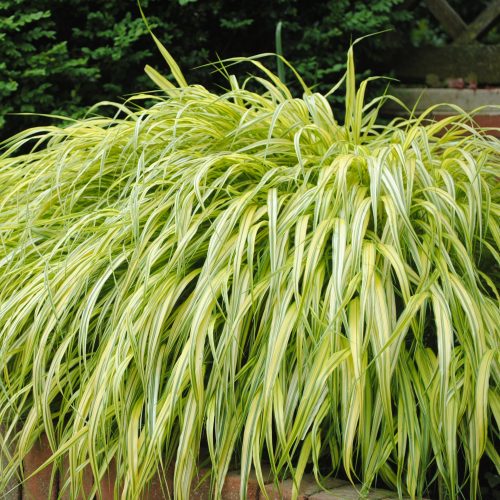
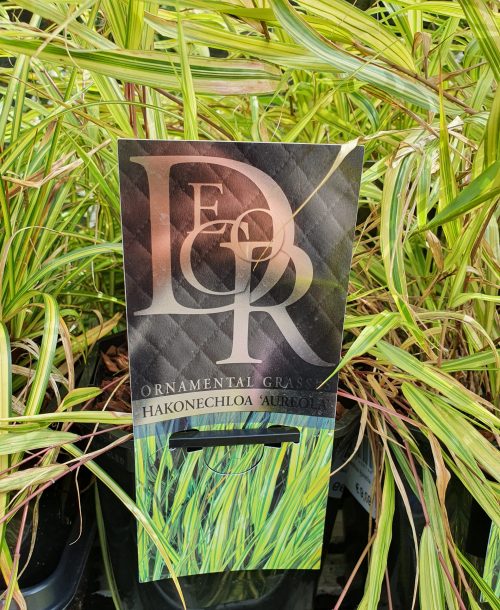 A cultivar of Japanese forest grass which makes a splash of colour in the garden, Hakonechloa macra Aureola is a clump-forming, deciduous, perennial grass which forms a broad, low, dense mound of narrow, arching, rather bamboo-like leaves. They are butter-yellow, striped with green, appear in early spring, keep their bright colour throughout the season, and are often tinged with coppery red in autumn. The colour is best in partial shade, turning shades of green in full shade. Tiny, insignificant, brown flowers appear in summer. Golden hakonechloa is tough, easy-to-grow and very hardy. It holds the RHS Award of Garden Merit. Site: Tolerates exposure Soil: Any moist but well-drained soil Position: Colours best in partial shade; tolerates full sun and full shade Season of interest: Spring to autumn Hardiness: Very hardy Height: 14”’ (35cm) Spread: 16” (40cm)
A cultivar of Japanese forest grass which makes a splash of colour in the garden, Hakonechloa macra Aureola is a clump-forming, deciduous, perennial grass which forms a broad, low, dense mound of narrow, arching, rather bamboo-like leaves. They are butter-yellow, striped with green, appear in early spring, keep their bright colour throughout the season, and are often tinged with coppery red in autumn. The colour is best in partial shade, turning shades of green in full shade. Tiny, insignificant, brown flowers appear in summer. Golden hakonechloa is tough, easy-to-grow and very hardy. It holds the RHS Award of Garden Merit. Site: Tolerates exposure Soil: Any moist but well-drained soil Position: Colours best in partial shade; tolerates full sun and full shade Season of interest: Spring to autumn Hardiness: Very hardy Height: 14”’ (35cm) Spread: 16” (40cm) -
Out of stock
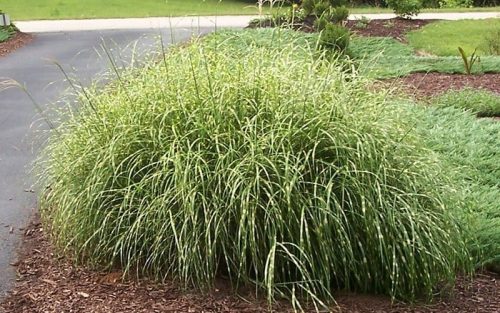
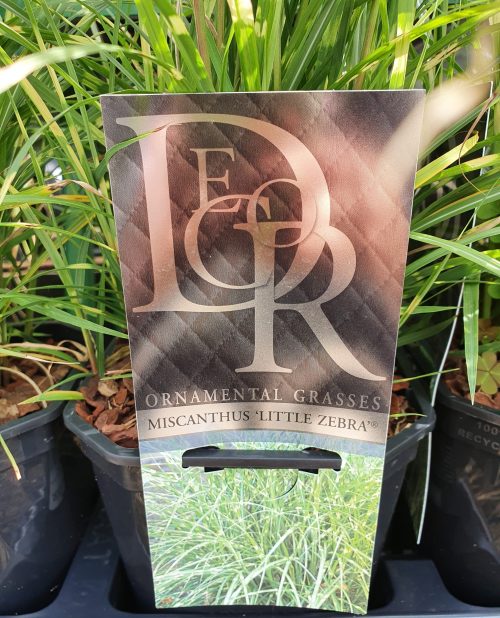 Little Zebra Grass features horizontal gold-and-green bands and a compact, mounding habit. In early fall, this spunky grass sends out attractive reddish, fan-shaped blooms that are held one foot above the foliage. The plumes change to a creamy tan color providing winter interest in the landscape. Because of its size and shape, Little Zebra Grass is the right proportion for small gardens, patios and decks. Its decorative leaves earn it a favored spot in large planters and urns. This sturdy dwarf Miscanthus holds its shape. Miscanthus sinensis ‘Little Zebra’ is unlikely to reseed because of its late-blooming characteristic. Foliage Type: Deciduous. Foliage: Green and Creamy-Yellow. Flower: Pale Pink to Silver. Flowering Period: Late-Summer. Suggested Location: Outdoor or Indoor. Suggested Soil Type: Well-Drained. Sand. Clay. Chalk. Loam. Suggested Exposure to Sunlight: Full Sunlight. Suggested Exposure to Weather: Exposed or Sheltered. Hardiness Rating: High Lowest Temperature Tolerance: -20 °C to -15 °C (-4 °F to 5 °F) Suggested Uses: Rock Gardens. Borders. Containers. Arrangements of Cut Flowers. Maintenance: Remove dead leaves and flowers in spring. Protect against excessive wet weather. Growth Habit: Bushy/Weeping. Growth Speed: Medium (30cm to 50cm per year) Starting Height: 30cm to 60cm (1.0 ft to 2.0 ft) Final Height: 100cm (3.2 ft) Starting Sideways Spread: 20cm to 40cm (0.7 ft to 1.3 ft) Final Sideways Spread: 100cm (3.2 ft)
Little Zebra Grass features horizontal gold-and-green bands and a compact, mounding habit. In early fall, this spunky grass sends out attractive reddish, fan-shaped blooms that are held one foot above the foliage. The plumes change to a creamy tan color providing winter interest in the landscape. Because of its size and shape, Little Zebra Grass is the right proportion for small gardens, patios and decks. Its decorative leaves earn it a favored spot in large planters and urns. This sturdy dwarf Miscanthus holds its shape. Miscanthus sinensis ‘Little Zebra’ is unlikely to reseed because of its late-blooming characteristic. Foliage Type: Deciduous. Foliage: Green and Creamy-Yellow. Flower: Pale Pink to Silver. Flowering Period: Late-Summer. Suggested Location: Outdoor or Indoor. Suggested Soil Type: Well-Drained. Sand. Clay. Chalk. Loam. Suggested Exposure to Sunlight: Full Sunlight. Suggested Exposure to Weather: Exposed or Sheltered. Hardiness Rating: High Lowest Temperature Tolerance: -20 °C to -15 °C (-4 °F to 5 °F) Suggested Uses: Rock Gardens. Borders. Containers. Arrangements of Cut Flowers. Maintenance: Remove dead leaves and flowers in spring. Protect against excessive wet weather. Growth Habit: Bushy/Weeping. Growth Speed: Medium (30cm to 50cm per year) Starting Height: 30cm to 60cm (1.0 ft to 2.0 ft) Final Height: 100cm (3.2 ft) Starting Sideways Spread: 20cm to 40cm (0.7 ft to 1.3 ft) Final Sideways Spread: 100cm (3.2 ft) -
Out of stock
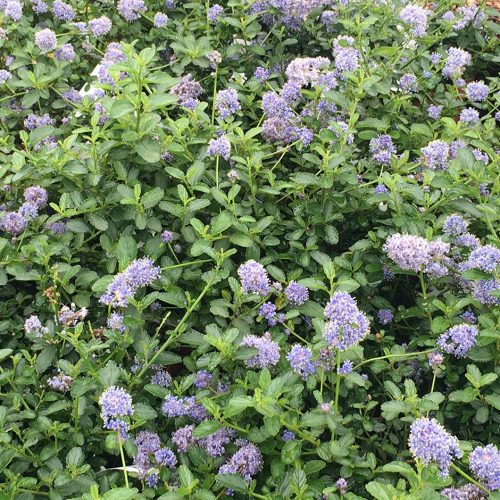
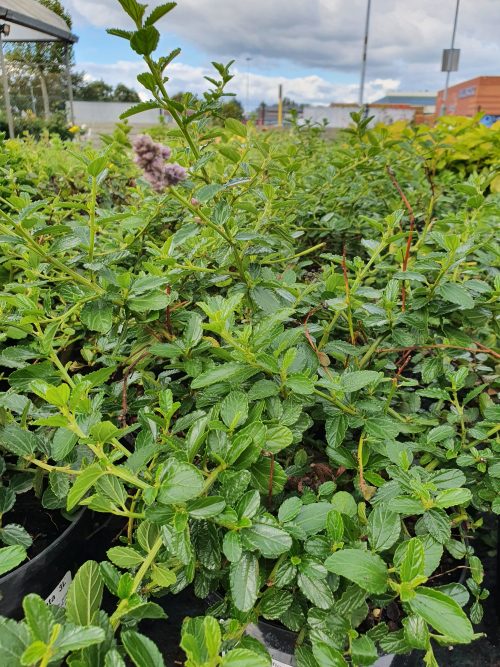 A deep blue flowering bushy garden shrub, which produces a wealth of deep powder blue flower heads from late spring into summer, combined with its glossy evergreen foliage. They’re fast growing and will be an asset to any garden!Covers bare spots quicklyBee friendly
A deep blue flowering bushy garden shrub, which produces a wealth of deep powder blue flower heads from late spring into summer, combined with its glossy evergreen foliage. They’re fast growing and will be an asset to any garden!Covers bare spots quicklyBee friendly- Covers bare spots quickly
- Bee Friendly
- Blooms: July - September
- Flower colour: blue
- Full grown height: 75 - 100 cm
- Full grown width: 1 - 1.50 m
- Plant location: sunny
- Plant spacing: 150 cm
- Hardiness: -10 Celsius
- Preferred soil: Grows in any soil
-
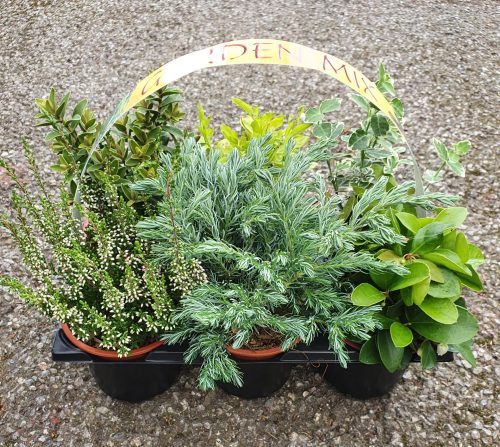
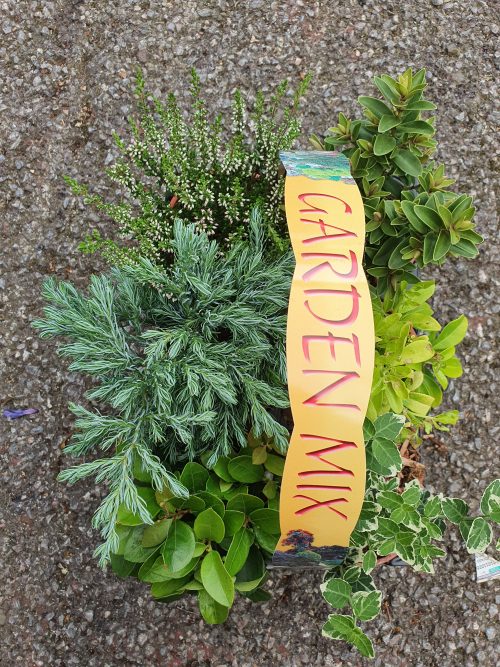 Conifers and Shrubs in 6 pack mixed.
Conifers and Shrubs in 6 pack mixed. -
Out of stock
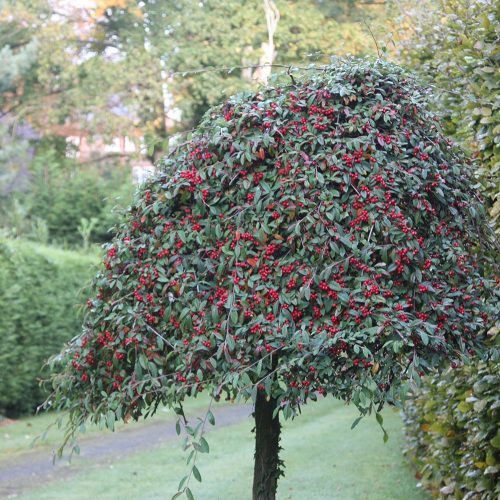
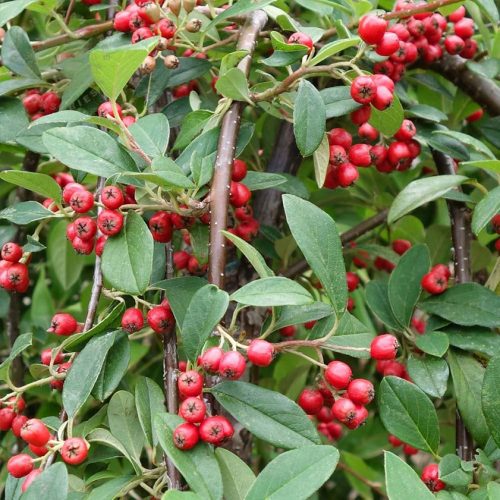 Cotoneaster Hybrida Pendula 'Hybridus Pendulus' is a vigorous prostrate evergreen shrub with large, elliptic leaves and small white flowers followed by profuse red berries in autumn; often top-grafted to form a pendulous small tree to 2m tall. CHARACTERISTICS: HARDINESS: Fully Hardy SOIL: moderately fertile, well-drained soil POSITION: Full Sun or Partial Shade FLOWERING PERIOD: June Fully Grown Height & Spread: 2m x 2m
Cotoneaster Hybrida Pendula 'Hybridus Pendulus' is a vigorous prostrate evergreen shrub with large, elliptic leaves and small white flowers followed by profuse red berries in autumn; often top-grafted to form a pendulous small tree to 2m tall. CHARACTERISTICS: HARDINESS: Fully Hardy SOIL: moderately fertile, well-drained soil POSITION: Full Sun or Partial Shade FLOWERING PERIOD: June Fully Grown Height & Spread: 2m x 2m -
Out of stock
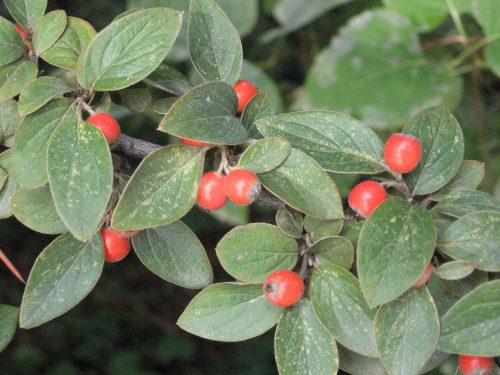
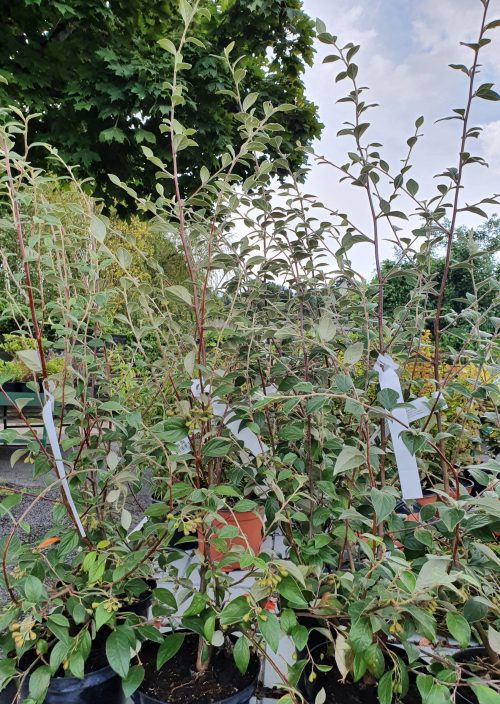 Franchet's Cotoneaster is a popular ornamental semi- evergreen shrub that produces masses of white flowers, during the summer followed by bright orange-red fruit in autumn. Its dense foliage makes it sought after by pollinating insects. Its easy to maintain and is fast-growing. Can also be used as a hedge, making it valuable shrub for both the gardener and the landscaper.Evergreen
Franchet's Cotoneaster is a popular ornamental semi- evergreen shrub that produces masses of white flowers, during the summer followed by bright orange-red fruit in autumn. Its dense foliage makes it sought after by pollinating insects. Its easy to maintain and is fast-growing. Can also be used as a hedge, making it valuable shrub for both the gardener and the landscaper.Evergreen- Blooms: May - June
- Flower colour: white
- Full grown: 5 Years
- Full grown height: 50 - 75 cm
- Full grown width: 75 - 100 cm
- Plant location: partial sunny location
- Plant spacing: 100 cm
- Hardiness: -25 Celsius
- Preferred soil: Well drained
-
Out of stock
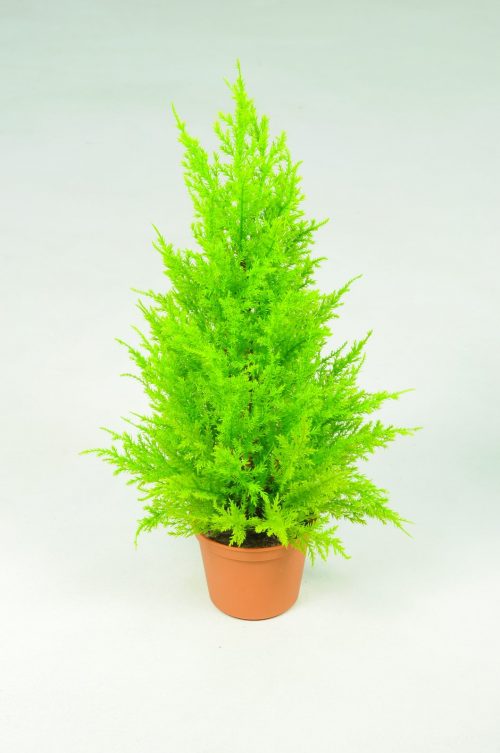 Cupressus macrocarpa 'Goldrest Wilma' is one of the most attractive golden-foliage columnar conifers. Bright golden-yellow foliage. Any free-draining soil in sun or partial shade. Rate of growth up to 60cm per year. Can be used for hedging but doesn't trim quite as well as leylandii. If used for hedging, plant 60-90cm apart. Can be trimmed to keep at the required height Plant Size • Mature Height: 10m • Mature Spread: 2-3m Why We Love It • These trees work wonderfully as topiaries • Fresh lemony scent • Easy to maintain What To Know • Fruit Season: Fall • Position: Full sun • Soil: Well drained • Rate of Growth: Moderate to fast How to Care • In general, growing lemon cypress is not difficult. The trees require well-draining soil, but are not picky about whether it is loamy, sandy or chalky. They also accept acidic, neutral or alkaline soil. • Water regularly - weekly, or more often in extreme heat or containers. • Trimming/Pruning If this plant is used for hedging, it will need to be pruned regularly. It will have to be trimmed to maintain the required height. Use sharp pruning shears to remove the sucker branches and the errant branches that are growing in the wrong direction or making it difficult to fertilize the tree. Since lemon cypress has a conical habit, trim the tree as per its natural shape. Trimming should be done every week during the summer. • Fertilizer Fertilize with the standard, slow-releasing fertilizer that has an equal amount of nitrogen, phosphorus, and potassium once a month. You can also supplement the soil annually with turf fertilizers that contain other nutrients such as magnesium, boron, copper, and zinc
Cupressus macrocarpa 'Goldrest Wilma' is one of the most attractive golden-foliage columnar conifers. Bright golden-yellow foliage. Any free-draining soil in sun or partial shade. Rate of growth up to 60cm per year. Can be used for hedging but doesn't trim quite as well as leylandii. If used for hedging, plant 60-90cm apart. Can be trimmed to keep at the required height Plant Size • Mature Height: 10m • Mature Spread: 2-3m Why We Love It • These trees work wonderfully as topiaries • Fresh lemony scent • Easy to maintain What To Know • Fruit Season: Fall • Position: Full sun • Soil: Well drained • Rate of Growth: Moderate to fast How to Care • In general, growing lemon cypress is not difficult. The trees require well-draining soil, but are not picky about whether it is loamy, sandy or chalky. They also accept acidic, neutral or alkaline soil. • Water regularly - weekly, or more often in extreme heat or containers. • Trimming/Pruning If this plant is used for hedging, it will need to be pruned regularly. It will have to be trimmed to maintain the required height. Use sharp pruning shears to remove the sucker branches and the errant branches that are growing in the wrong direction or making it difficult to fertilize the tree. Since lemon cypress has a conical habit, trim the tree as per its natural shape. Trimming should be done every week during the summer. • Fertilizer Fertilize with the standard, slow-releasing fertilizer that has an equal amount of nitrogen, phosphorus, and potassium once a month. You can also supplement the soil annually with turf fertilizers that contain other nutrients such as magnesium, boron, copper, and zinc -
Out of stock
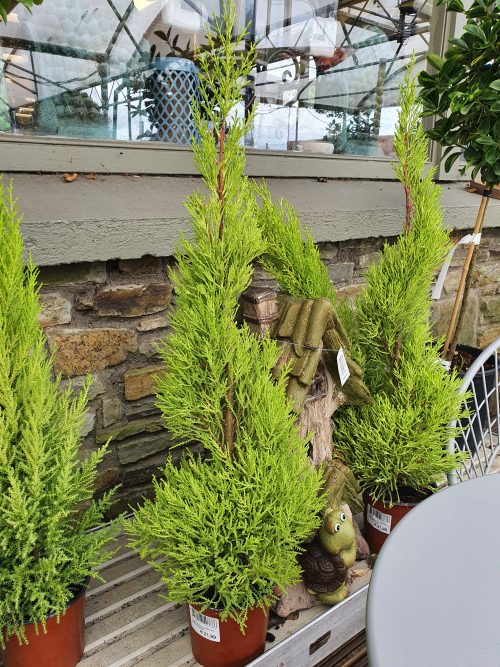
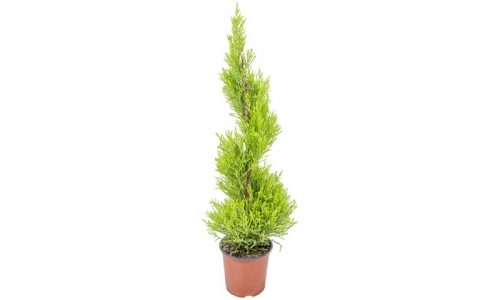 Cupressus macrocarpa 'Goldrest Wilma' is one of the most attractive golden-foliage columnar conifers. Bright golden-yellow foliage. Any free-draining soil in sun or partial shade. Rate of growth up to 60cm per year. Can be used for hedging but doesn't trim quite as well as leylandii. If used for hedging, plant 60-90cm apart. Can be trimmed to keep at the required height Plant Size • Mature Height: 10m • Mature Spread: 2-3m Why We Love It • These trees work wonderfully as topiaries • Fresh lemony scent • Easy to maintain What To Know • Fruit Season: Fall • Position: Full sun • Soil: Well drained • Rate of Growth: Moderate to fast How to Care • In general, growing lemon cypress is not difficult. The trees require well-draining soil, but are not picky about whether it is loamy, sandy or chalky. They also accept acidic, neutral or alkaline soil. • Water regularly - weekly, or more often in extreme heat or containers. • Trimming/Pruning If this plant is used for hedging, it will need to be pruned regularly. It will have to be trimmed to maintain the required height. Use sharp pruning shears to remove the sucker branches and the errant branches that are growing in the wrong direction or making it difficult to fertilize the tree. Since lemon cypress has a conical habit, trim the tree as per its natural shape. Trimming should be done every week during the summer. • Fertilizer Fertilize with the standard, slow-releasing fertilizer that has an equal amount of nitrogen, phosphorus, and potassium once a month. You can also supplement the soil annually with turf fertilizers that contain other nutrients such as magnesium, boron, copper, and zinc
Cupressus macrocarpa 'Goldrest Wilma' is one of the most attractive golden-foliage columnar conifers. Bright golden-yellow foliage. Any free-draining soil in sun or partial shade. Rate of growth up to 60cm per year. Can be used for hedging but doesn't trim quite as well as leylandii. If used for hedging, plant 60-90cm apart. Can be trimmed to keep at the required height Plant Size • Mature Height: 10m • Mature Spread: 2-3m Why We Love It • These trees work wonderfully as topiaries • Fresh lemony scent • Easy to maintain What To Know • Fruit Season: Fall • Position: Full sun • Soil: Well drained • Rate of Growth: Moderate to fast How to Care • In general, growing lemon cypress is not difficult. The trees require well-draining soil, but are not picky about whether it is loamy, sandy or chalky. They also accept acidic, neutral or alkaline soil. • Water regularly - weekly, or more often in extreme heat or containers. • Trimming/Pruning If this plant is used for hedging, it will need to be pruned regularly. It will have to be trimmed to maintain the required height. Use sharp pruning shears to remove the sucker branches and the errant branches that are growing in the wrong direction or making it difficult to fertilize the tree. Since lemon cypress has a conical habit, trim the tree as per its natural shape. Trimming should be done every week during the summer. • Fertilizer Fertilize with the standard, slow-releasing fertilizer that has an equal amount of nitrogen, phosphorus, and potassium once a month. You can also supplement the soil annually with turf fertilizers that contain other nutrients such as magnesium, boron, copper, and zinc -
Out of stock
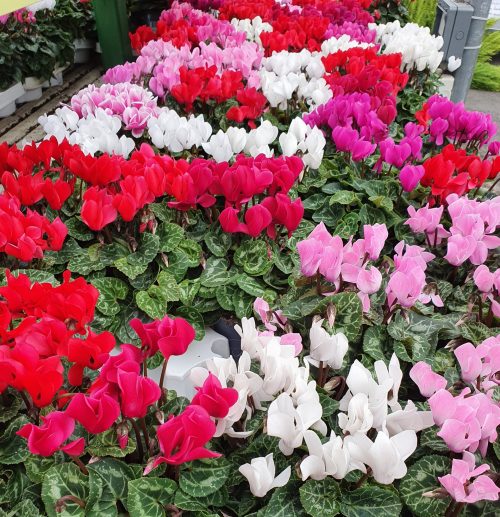
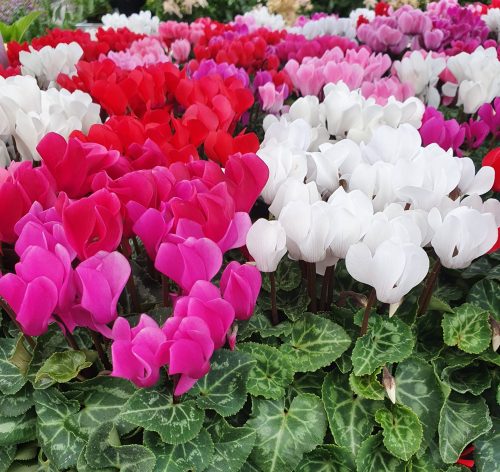 The life cycle of hardy cyclamen is unusual. It begins in September when dozens of small pink flowers begin to bloom before the leaves emerge. Each flower is on a separate 4 ” stem and looks just like a miniature florist cyclamen flower with gorgeous reflexed petals. The flowers continue to be produced abundantly in succession through out the months of September and October and sometimes for parts of August and November too. They emerge slowly as the flowers are blooming in late September and take several weeks to reach their full size. “Variable” is an understatement to describe their wonderful shapes, patterns, and colors. They can be round to lance-shaped, lobed or entire, serrated or smooth edged, dark green to silver. And the patterns on the leaves are indescribable. They stay green and fresh all winter! Instead of going dormant in the winter like most of our plants, hardy cyclamen goes dormant for a few months during the summer.
The life cycle of hardy cyclamen is unusual. It begins in September when dozens of small pink flowers begin to bloom before the leaves emerge. Each flower is on a separate 4 ” stem and looks just like a miniature florist cyclamen flower with gorgeous reflexed petals. The flowers continue to be produced abundantly in succession through out the months of September and October and sometimes for parts of August and November too. They emerge slowly as the flowers are blooming in late September and take several weeks to reach their full size. “Variable” is an understatement to describe their wonderful shapes, patterns, and colors. They can be round to lance-shaped, lobed or entire, serrated or smooth edged, dark green to silver. And the patterns on the leaves are indescribable. They stay green and fresh all winter! Instead of going dormant in the winter like most of our plants, hardy cyclamen goes dormant for a few months during the summer. -
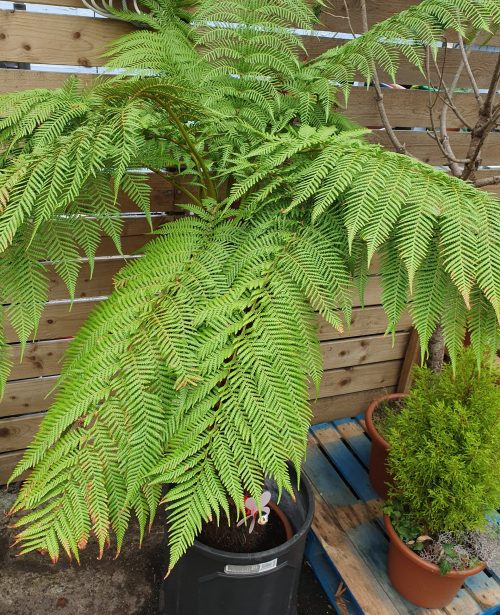
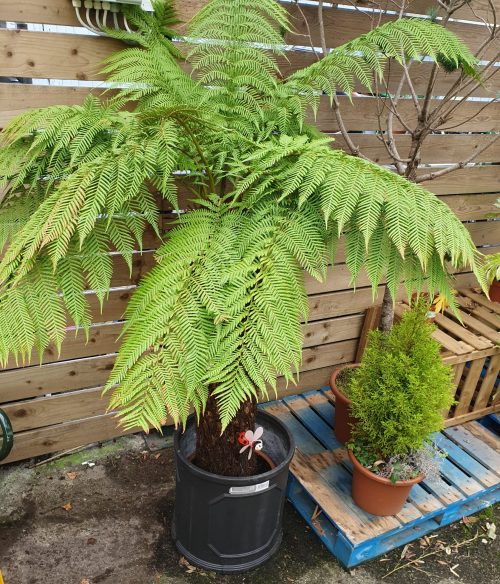 Native to coastal parts of Australia, Dicksonia antarctica is a magnificent, slow-growing, evergreen tree-fern (deciduous in colder areas) and one of the easiest to grow. The brown, fibrous ‘stem’ slowly grows taller, crowned by a rosette of beautiful, glossy, deep green fronds up to three metres long – a wonderfully architectural plant. Winter protection essential in all but the mildest areas – wrap the top of the ‘stem’ in fleece and protect the growing point in the crown with straw or similar insulation, and if pot-grown, bring inside or insulate the pot. Water the stem in hot weather; do not water the crown in winter. Site: Sheltered, sheltered coastal Soils: Moist but well-drained, acid to neutral soil Position: Partial shade or dappled shade Season of interest: Most of the year Hardiness: Frost-hardy Height to 13’ (4m) Spread to 13’ (4m)
Native to coastal parts of Australia, Dicksonia antarctica is a magnificent, slow-growing, evergreen tree-fern (deciduous in colder areas) and one of the easiest to grow. The brown, fibrous ‘stem’ slowly grows taller, crowned by a rosette of beautiful, glossy, deep green fronds up to three metres long – a wonderfully architectural plant. Winter protection essential in all but the mildest areas – wrap the top of the ‘stem’ in fleece and protect the growing point in the crown with straw or similar insulation, and if pot-grown, bring inside or insulate the pot. Water the stem in hot weather; do not water the crown in winter. Site: Sheltered, sheltered coastal Soils: Moist but well-drained, acid to neutral soil Position: Partial shade or dappled shade Season of interest: Most of the year Hardiness: Frost-hardy Height to 13’ (4m) Spread to 13’ (4m) -
Out of stock
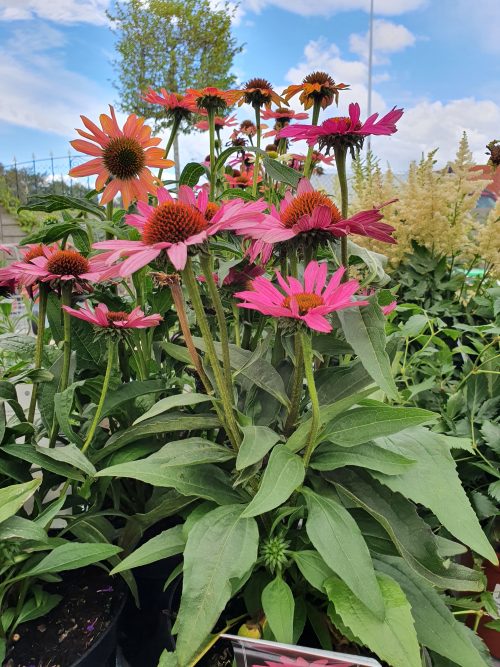
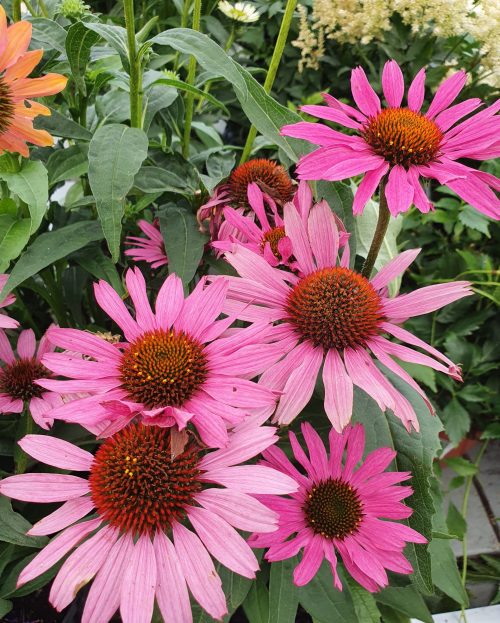 Echinaceas have grown in popularity in recent years, thanks to the trend for prairie-style planting. They’re easy to grow as they tolerate most soils, and their sturdy nature means that staking is unnecessary. Echinacea purpurea has pink, daisy-like flowers with a large, cone-shaped centre. It’s perfect for growing in drifts among the border or among grasses and rudbeckias in a prairie-style planting scheme, and is extremely attractive to pollinators. Its flowers are long-lived and are excellent for cutting.
Echinaceas have grown in popularity in recent years, thanks to the trend for prairie-style planting. They’re easy to grow as they tolerate most soils, and their sturdy nature means that staking is unnecessary. Echinacea purpurea has pink, daisy-like flowers with a large, cone-shaped centre. It’s perfect for growing in drifts among the border or among grasses and rudbeckias in a prairie-style planting scheme, and is extremely attractive to pollinators. Its flowers are long-lived and are excellent for cutting.Characteristics
- Plant Type: Herbaceous perennial
- Habit: Tall, upright flower
- Fully Grown Size: 90-120cm
- Flower Colour: Purple / pink petals with orange / brown centre
- Flower heads can reach 12cm in size
- Flowering Time: Summer to early Autumn
- Sow: In early to mid Spring
- Spacing: 60-80cm
- Hardiness: Hardy
- With big flower heads, Echinacea have grown in popularity in recent years
- These tall & brightly coloured, daisy-like flowers are essential in any garden
- Suited to both traditional, cottage & modern planting schemes
- Plant at back of borders with other herbaceous plants
- Best when planted in clumps / blocks
- Can also be planted in long sweeping drifts
- Companion plants include Rudbeckia, Agapanthus, Verbena, Red Hot Pokers etc..
- Ideal for cut flower gardens
Planting Instructions
- Soak pots in water before sowing
- Choose a location
- Grow in full sun
- Deep, fertile soil that is well drained
- Chose a sheltered spot
- Spacing: 60-80cm apart
- Prepare bed by digging over soil & adding fertilizer or manure
- Dig hole roughly twice the size of the plant pot
- Handle pots with care
- Squeeze side of pots to remove plant
- Firm in well
- Soak soil well after planting
- Feed every 2 to 3 weeks
- Can lift & divide clumps every 3 years
-
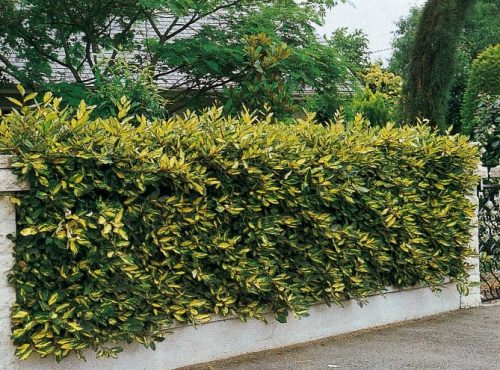
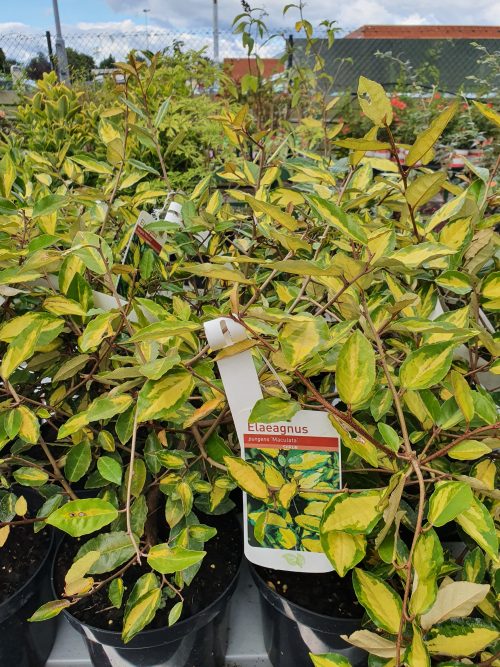 The Elaeagnus Pungens Maculata is a beautiful and colourful, bushy evergreen hedge. It has scaly leaves that are silver in colour, however they soon turn into a mature yet young looking vibrant yellow and green colour. It produces small, scented, white tubular flowers during the autumnal months that are followed by fruit that is small and juicy in the spring. The Elaeagnus Pungens Maculata prefers soil that is either sand, loam, chalk or clay, but must be well drained. It can either be planted in a sunny position or where there is partial shade, and it doesn’t mind whether that is in an exposed or sheltered position. It can grow up to four metres high and between two and a half to four meters wide in two to five years, which is quicker than the rest of its family. On average, it will grow up to one foot a year. It’s best to prune these during the late spring, preferably in either April or May, once it has finished producing its fruit. When it comes to planting the Elaeagnus Pungens Maculata we would suggest to plant it eighteen to twenty-four inches apart from one another. It works really well as an all year privacy hedge thanks to being evergreen. We have a range of Elaeagnus Pungens Maculata plants available in pot form.
The Elaeagnus Pungens Maculata is a beautiful and colourful, bushy evergreen hedge. It has scaly leaves that are silver in colour, however they soon turn into a mature yet young looking vibrant yellow and green colour. It produces small, scented, white tubular flowers during the autumnal months that are followed by fruit that is small and juicy in the spring. The Elaeagnus Pungens Maculata prefers soil that is either sand, loam, chalk or clay, but must be well drained. It can either be planted in a sunny position or where there is partial shade, and it doesn’t mind whether that is in an exposed or sheltered position. It can grow up to four metres high and between two and a half to four meters wide in two to five years, which is quicker than the rest of its family. On average, it will grow up to one foot a year. It’s best to prune these during the late spring, preferably in either April or May, once it has finished producing its fruit. When it comes to planting the Elaeagnus Pungens Maculata we would suggest to plant it eighteen to twenty-four inches apart from one another. It works really well as an all year privacy hedge thanks to being evergreen. We have a range of Elaeagnus Pungens Maculata plants available in pot form. -
Out of stock
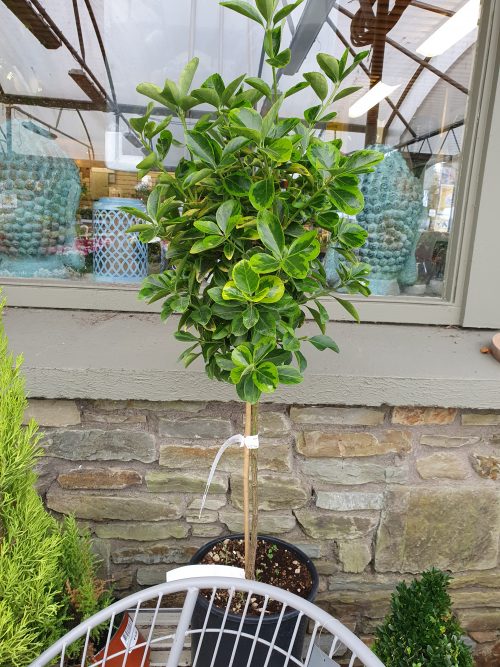
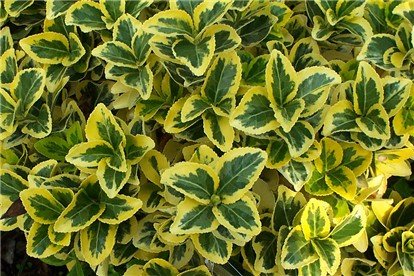 Euonymus japonicus Aureus is an evergreen variety and provides year round interest. Excellent for growing as a specimen shrub or small hedge. Also suitable for coastal areas. The attractive leathery leaves are dark green with bright yellow edges.A Decorative Foliage
Euonymus japonicus Aureus is an evergreen variety and provides year round interest. Excellent for growing as a specimen shrub or small hedge. Also suitable for coastal areas. The attractive leathery leaves are dark green with bright yellow edges.A Decorative Foliage- Pot size: 7.5L
- Height: 4m
- Spread: 2m
- Leaf colour: variegated
- Plant location: sunny
- Plant depth: 15 cm
- Hardiness: -15 Celsius
- Harmful if eaten
- Preferred soil: Grows in any soil
-
Out of stock
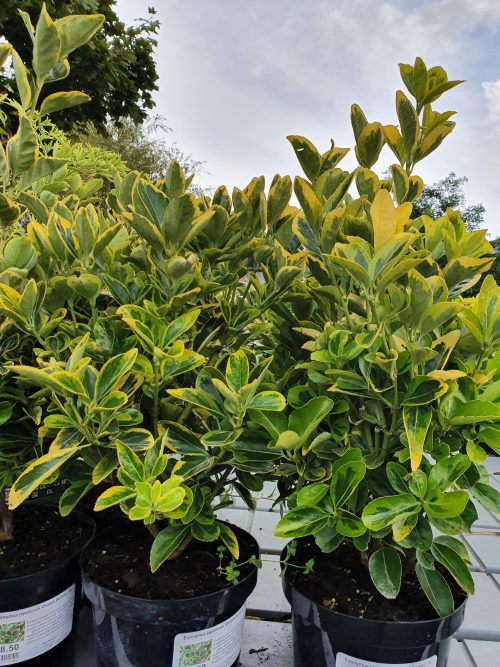 Euonymus Japonicus Aureus is an evergreen variety and provides year round interest. Excellent for growing as a specimen shrub or small hedge. Also suitable for coastal areas. The attractive leathery leaves are dark green with bright yellow edges.Decorative foliage
Euonymus Japonicus Aureus is an evergreen variety and provides year round interest. Excellent for growing as a specimen shrub or small hedge. Also suitable for coastal areas. The attractive leathery leaves are dark green with bright yellow edges.Decorative foliage -
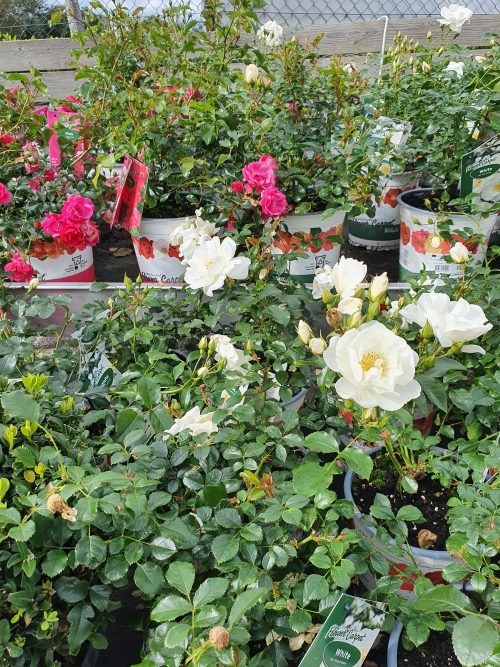 Lower Carpet Roses – also often referred to as The Carpet Rose – are the world’s number one ground cover rose. Once established, some varieties can produce an astonishing display of up to 2,000 flowers from spring through to autumn. They’re extraordinarily low maintenance and have exceptional disease resistance. Better still, once established their well-developed root system means they’re drought and low-water tolerant: surface roots take up available surface water while deeper roots access lower level water in drought conditions. As for pruning, once a year in late winter or early spring, all you need is a pair of garden shears to cut them back by a third any which way. This is the rose that needs no guessing, no worrying. Really… No kidding. Simple to grow and easy to maintain, it doesn't require spraying. Simply cut back to a third of its size once in late Winter or early Spring. And during the long flowering season, this rose will self-clean so that there's no need for fancy pruning or deadheading. Key Features •Masses of iridescent blooms •Rich glossy green foliage •Attractive bush shape and appearance •Disease-resistance, easy-care maintenance •Easy care •No fancy pruning required
Lower Carpet Roses – also often referred to as The Carpet Rose – are the world’s number one ground cover rose. Once established, some varieties can produce an astonishing display of up to 2,000 flowers from spring through to autumn. They’re extraordinarily low maintenance and have exceptional disease resistance. Better still, once established their well-developed root system means they’re drought and low-water tolerant: surface roots take up available surface water while deeper roots access lower level water in drought conditions. As for pruning, once a year in late winter or early spring, all you need is a pair of garden shears to cut them back by a third any which way. This is the rose that needs no guessing, no worrying. Really… No kidding. Simple to grow and easy to maintain, it doesn't require spraying. Simply cut back to a third of its size once in late Winter or early Spring. And during the long flowering season, this rose will self-clean so that there's no need for fancy pruning or deadheading. Key Features •Masses of iridescent blooms •Rich glossy green foliage •Attractive bush shape and appearance •Disease-resistance, easy-care maintenance •Easy care •No fancy pruning required -
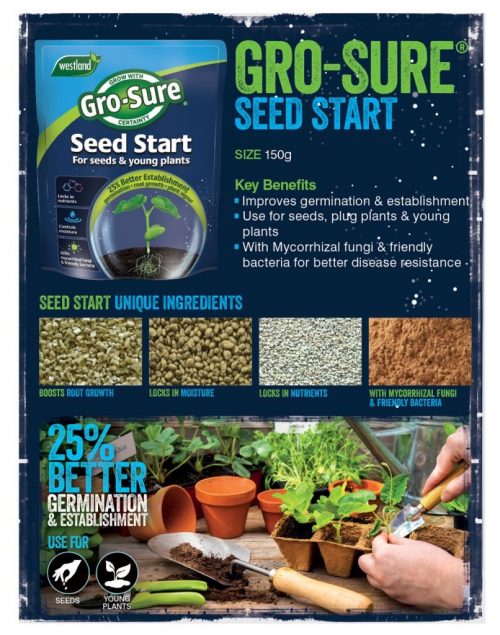
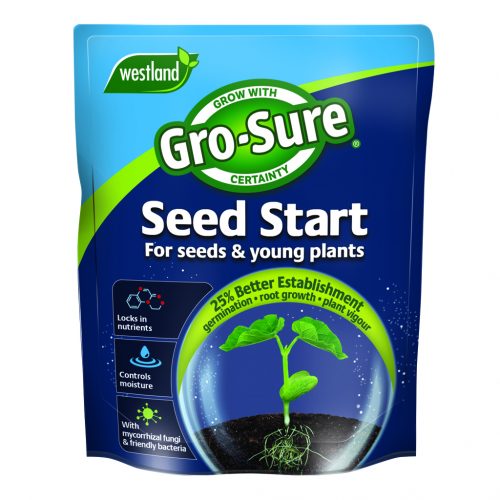 Gro-Sure Seed Start’s natual blend of mycorrhizal fungi and friendly bacteria improves germination and establishment of seeds and young plants.
Gro-Sure Seed Start’s natual blend of mycorrhizal fungi and friendly bacteria improves germination and establishment of seeds and young plants.- 25% better establishment
- Boosts root growth
- Locks in nutrients
- Controls moisture
- Contains mycorrhizal fungi and friendly bacteria
- Water is held around the seed to aid germination
- Mycorrhizal fungi & friendly bacteria enhance root development
- Nutrients are held in the soil and feed the plant during the establishment
- Seeds must be kept constantly moist to soften the seed shell in order for germination to take place
- Seeds must be moist, NOT wet. Insufficient moisture or erratic watering slows down or stops the germination process. Our added wetting agent locks in moisture around the seed and therefore germination is improved
- Added clinoptiloite, a natural zeolite or volcanic rock dust, contains an array of basic nutrients and its crystalline structure grabs hold of other available nutrients in the soil stopping them being leached away
- These nutrients are available to the root system of the plant while its structure also aerates the soil. Roots need to breathe
- Vermiculite opens up the growing medium so young roots can permeate more easily. Holding a considerable amount of moisture like a sponge it can also act as blanket to help keep seedlings warm and is particularly good for lightly covering sown seedlings
- Fortified with beneficial mycorrhizal fungi which attach to the developing plants’ roots in exchange for some plant sugars. They quickly multiply forming their own extensive root supply, which absorbs nutrients and water to feed back to their host plant.
- The plant’s absorptive root system is increased greatly and the plant is able to grow faster and stronger
- Our blend of naturally occurring ‘friendly’ soil bacteria’s including trichoderma and bacillus colonise the root system. Because each pack of Seed Start contains millions of friendly bacteria they out-compete harmful soil pathogens within the soil, which cause plant diseases. It does all of this while also releasing locked up nutrients within the soil for the plants roots to uptake
-
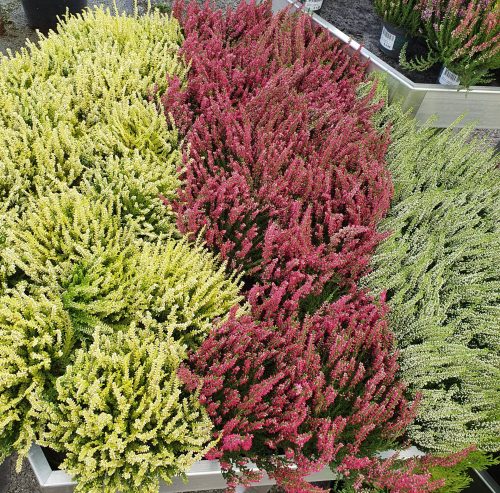
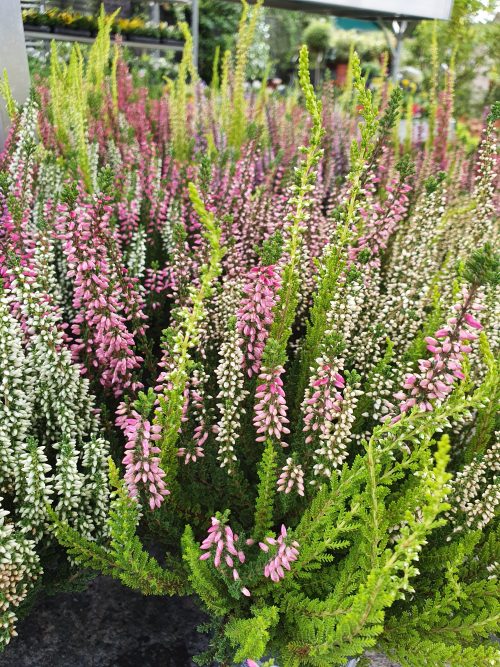 Calluna vulgaris, also known as common Scotch Heather is a low growing perennial shrub; it blooms with very long lasting, sweet smelling flowers in late summer that will attract many insects with their sweet nectar in late summer. Their dense spreading habit makes them perfect as a ground covering plant or for a charming display on your patio or balcony.
Calluna vulgaris, also known as common Scotch Heather is a low growing perennial shrub; it blooms with very long lasting, sweet smelling flowers in late summer that will attract many insects with their sweet nectar in late summer. Their dense spreading habit makes them perfect as a ground covering plant or for a charming display on your patio or balcony.- Fragrant
- Covers bare spots quickly
- Bee Friendly
- Blooms: August - September
- Flower colour: red
- Full grown height: 25 - 50 cm
- Full grown width: 10 - 25 cm
- Plant location: sunny
- Plant spacing: 35 cm
- Hardiness: -15 Celsius
- Preferred soil: Peaty Soil